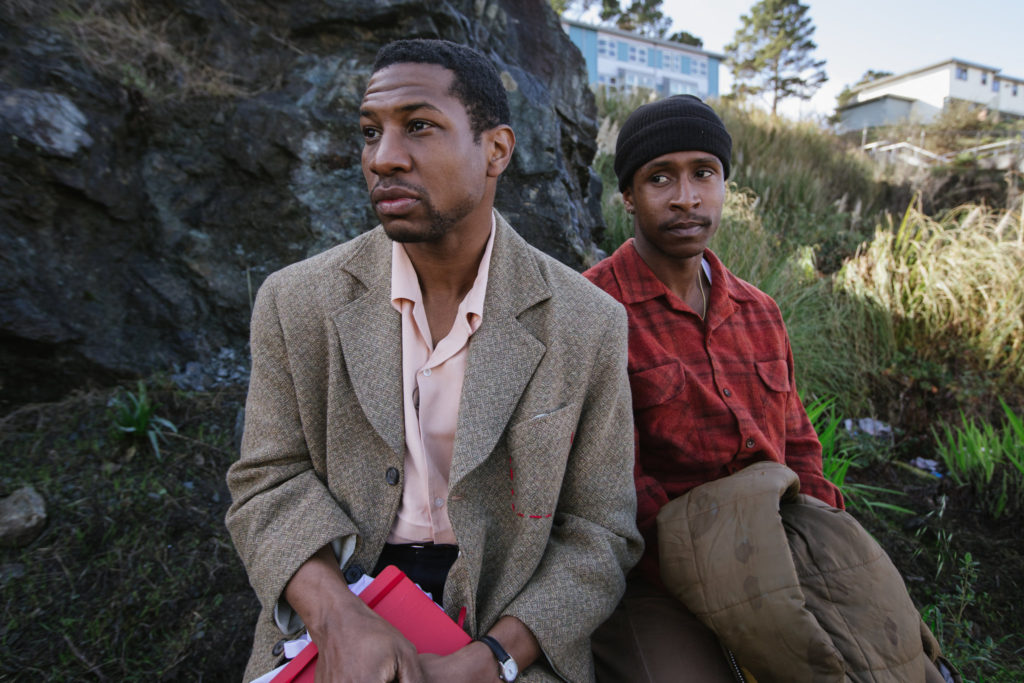
Jonathan Majors and Jimmie Fails in THE LAST BLACK MAN IN SAN FRANCISCO.
Photo: Peter Prato/A24
The Last Black Man in San Francisco is an absorbing exploration of the inner lives of two friends as they react to their changing city – and it’s one of the best films of the year.
Jimmie Fails (played by the film’s co-writer Jimmie Fails) shares a cramped room with his best friend Mont (Jonathan Majors) in Mont’s grandfather’s tiny bungalow in San Francisco’s downscale Bayview-Hunter’s Point. Both have low-skill, low-wage jobs and live to explore San Francisco together, Jimmie on his beloved skateboard and Mont more ecumenical in mode of transportation. Mont is writing a play.
Jimmie worships his childhood home, a Victorian that his grandfather settled in the postwar 1940s, when the Fillmore District was a vibrant black working class neighborhood and a national jazz mecca. The neighborhood has changed since Jimmie’s parents lost the home decades ago, and the current white middle class owners can’t keep up the property to Jimmie’s standards. Understandably, they don’t appreciate Jimmie’s guerilla painting and gardening at their house. When the owners are also forced out, Jimmie moves into the vacant house; of course, he has no legal right to the house and he can’t afford even a fraction of its $4 million price tag.
Is Jimmy living a fantasy? Or living a lie? Is he clinging to a city that no longer exists? Can he demand a place in the new version of San Francisco?
Here’s what sets The Last Black Man in San Francisco apart. That which is imagined (Jimmy’s “ownership” of the house and Mont’s play) is depicted with stark reality. That which is real (both the harshly sobering and the pedestrian) is often dreamlike. The effect of The Last Black Man in San Francisco is that of watching someone’s dream. Of course, much about San Francisco is surreal.
Director and co-writer Joe Talbot, only 28 years old, is clearly a major talent. Effective use of the musical montage is rare these days, but his montage to San Francisco (Be Sure to Wear Flowers in Your Hair) is spell-binding and provocative. In this Rolling Stone interview, Talbot discusses his lifelong friendship with Fails and the genesis of the film.
This is a love letter to San Francisco – but a clear-eyed one. San Francisco’s beauty and quirks are celebrated; our heroes skateboard down the hills before a backdrop of architectural charm and famous vistas. But the beautiful interior woodwork of the Fillmore Victorian is juxtaposed against the barren and toxic waterfront of Bayview-Hunters Point. Many movies are set in San Francisco – this is the one that best captures the current 2019 evolution, with its demographic and economic changes and their societal and cultural costs. Bay Area residents will especially enjoy inside references like the Segway tours for tourists (with the guide impeccably played by Jello Biafra).
Since the Gold Rush, San Francisco’s cultural ethos has been to be supremely tolerant of eccentricities, even to a to a fault. It has proudly stood as a welcoming refuge for individuals to express their non-mainstream lifestyles and as a muse to creatives, homegrown and otherwise. Now the city has been made ideal for a culturally mainstream young business class and tourists. The working class – white, Latino and especially African-American – has been priced out.
The social criticism is often pointed. There’s the character of Clayton, a native San Franciscan who is embracing and profiting from gentrification; he’s a St. Ignatius grad of Irish stock with slick charm and slicker hair – check out his surname. And there’s a gang of drunken tech bros on a faux cable car party bus; they expose their invaders’ vulture culture by their reaction to a Naked Guy.
Jimmie Fails, who has the advantage of essentially playing himself, is so good that it’s surprising that he’s a first-time actor. It’s Fails’ inventive writing, however, that is even more impressive.
Jonathan Majors is a promising discovery. Mont toggles between being the sensible one who tempers Jimmy’s house-related compulsions to caring deeply, perhaps over-caring. Majors’ Mont is an uncommon man, and we’re never quite sure if his passions are entirely healthy. Majors studied at Yale Drama and will play Bobby Seale in Aaron Sorkin’s upcoming Trial of the Chicago 7.
There’s a Greek Chorus of street guys in Bayview-Hunters Point who spend their time insulting each other and passersby. These guys are like buoys – anchored to the ocean floor but powerless to affect anything on the ocean surface. Mont later describes one of the chorus, Kofi, as having been “born into a box”, living a life without viable choices.
Once, Mont “directs” the street guys as if they performing a play. A hostile situation is defused by their bewilderment; the play, of course, is in Mont’s head.
The Greek Chorus is played by non-actors. Danny Glover is superb as Mont’s blind grandfather. Rob Morgan soars as Jimmie’s simmering dad.
The Last Black Man in San Francisco is a startlingly original Must See.
